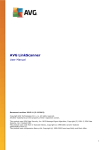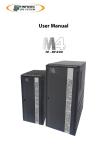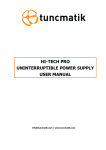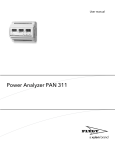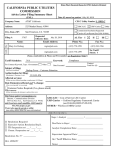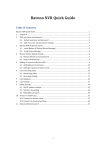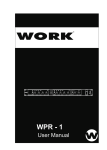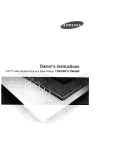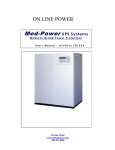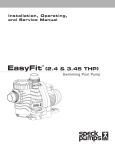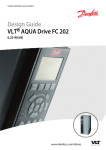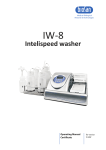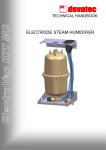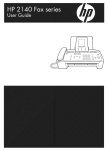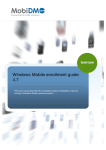Download PowerShield® Platinum
Transcript
PowerShield® Platinum USER Manual Platinum 15 – 80 kVA Online UPS with LCD Touch Screen Display November 2012 User Manual www.powershield.com.au 1 www.powershield.com.au ©PowerShield 2012 PowerShield® Platinum USER Manual INDEX 1 1.1. 1.2. 1.2.1. 1.2.2. 1.2.3. INTRODUCTION GENERAL. USING THIS MANUAL SYMBOLS AND MEANINGS. INFORMATION AND/OR HELP. SAFETY AND FIRST AID. 2 2.1. 2.2. 2.3. QUALITY, STANDARDS & ENVIRONMENT MANAGEMENT POLICY. STANDARDS. ENVIRONMENT. 3 3.1. 3.1.1. 3.1.2 3.1.3 3.1.4 3.1.5 3.2. 3.2.1. 3.3. 3.3.1 3.3.2. 3.3.3. 3.3.4. PRESENTATION EQUIPMENT VIEW UPS CABINETS CONTROL PANEL VIEW CONNECTIONS BATTERY CABINETS DRAWING LEGEND STRUCTURE TOPOLOGY. OPERATING PRINCIPLE. NORMAL OPERATION, (). OPERATION WITH MAINS FAILURE, (). OPERATION WITH INVERTER STOPPED, (). OPERATION IN MANUAL BYPASS, (). 4 4.1. 4.1.1. 4.1.2. 4.1.3 4.1.4 4.2. 4.2.1. 4.2.2. 4.2.3. 4.2.4. 4.2.5 4.3. 4.3.1. 4.3.2. 4.3.3. 4.3.4. 4.3.5. INSTALLATION IMPORTANT SAFETY INSTRUCTIONS. BATTERY SAFETY INSTRUCTIONS. UPS CABINET ACCESS SINGLE PHASE CURRENT TABLES THREE PHASE CURRENT TABLES EQUIPMENT RECEIPT UNPACKING AND CHECKING. LOCATION STORAGE TRANSPORT POSITIONING CONNECTION. BACKFEED PROTECTION INDEPENDENT STATIC BYPASS LINE . CONNECTION OF THE OUTPUT TERMINALS. UPS / BATTERY CONNECTIONS CONNECTION: MAIN PROTECTIVE EARTHING TERMINAL AND PROTECTIVE EARTH TERMINAL/S 4.3.6. COM PORT TO RELAY. CONNECTOR (X32). 4.3.7. PORT COM RS-232 & RS-485. CONNECTOR (X32). 4.3.8. EPO TERMINALS (X50). 2 www.powershield.com.au 5 5.1 5.1.1 5.1.2 5.1.3 5.1.4 5.1.5 OPERATION START UP START UP PREPARATION START UP PROCEDURE STARTING UP PARALLEL SYSTEMS SHUTTING DOWN ONE PARALLEL UNIT RESTARTING ONE PARALLEL UNIT 5.2 5.3 5.4 5.4.1 5.4.2 5.4.3 5.4.4 COMPLETE SHUTDOWN EPO OPERATION MAINTENANCE BYPASS SWITCH PRINCIPLE OF OPERATION TRANSFER TO MAINTENANCE BYPASS TRANSFER TO NORMAL OPERATION OPERATION OF EXTERNAL MAINT BYPASS 6 CONTROL PANEL AND DISPLAY 6.1 6.2 CONTROL PANEL ELEMENTS MESSAGES AND MENUS 6.3 6.3.1 6.3.2 6.3.3. 6.3.4. 6.3.5. 6.3.6. SCREEN MENU DESCRIPTION / SUBMENUS MAIN SCREEN LEVEL CONTROL AND STATUS MEASURES SETTINGS ALARMS DATA LOGGER 7 7.1 7.1.1. 7.1.2. 7.1.3. 7.1.4. 7.2. 7.2.1. 7.2.2. MAINTENANCE, WARRANTY AND SERVICE BASIC MAINTENANCE GUIDE. BATTERY FUSES. BATTERIES. FANS. CAPACITORS. WARRANTY CONDITIONS. PRODUCTCOVERED. SCOPE OF SUPPLY. 8 8.1. 8.2. 8.3. 8.3.1 8.3.2 8.3.3 8.3.4 8.3.5 ANNEXES SAFETY INSTRUCTIONS INSTALLATION CONNECTIONS NEUTRAL CONNECTION BATTERY BATTERY SAFETY 9 EXTERNAL MAINTENANCE BYPASS SWITCHES 9.1 9.2 EMBS CONFIGURATIONS TRAPPED KEY INTERLOCKS GENERAL TECHNICAL SPECIFICATIONS. GLOSSARY OF TERMS ©PowerShield 2012 PowerShield® Platinum USER Manual 1.2.1 Symbols and Meanings 1. INTRODUCTION Warning symbol. Carefully read the indicated paragraph and take the stated prevention measures. Danger of electrical shock symbol. Pay special attention to it, both where indicated on the equipment and in the paragraph referred to this Users manual. 1.1. GENERAL. Thank you for choosing a PowerShield® UPS. Ranging from 10K80KVA, Platinum is designed for maximum efficiency and energy savings with highly compact footprint. It makes installation and operation easy and i s environmentally friendly. P la t i n u m also has a wide range of communication possibilities with options to fill customers diverse needs. To facilitate expansion easily, this unit can be set up in parallel-redundant systems without any need for additional hardware in the future. Main protective earthing terminal symbol. Connect the earth cable coming from the incoming mains to this terminal. Earth bonding terminal». Connect the earth cable coming from the incoming supply to this terminal. Information symbol. Additional topics that complement the basic procedures. Very Important: WARRANTY REGISTRATION In order to validate product warranty, it is essential that you register your UPS on line. Preservation of the environment: The presence of this symbol in the product or in the associated documentation means thatat the end of its useful life, the item will be disposed of in compliance with local environmental laws and regulations. Please visit PowerShield on line product warranty web page www.powershield.com.au/product-registration.php This user manual contains instructions relating to safety, installation, operation, maintenance and warranty of this product. Please keep this manual in a safe place for future reference. The equipment described can cause significant physical damages if handled wrongly. Therefore the installation, maintenance and commissioning of the equipment must be done by our staff or specially authorised personnel. Our policy is one of constant improvement, we reserve the right to modify the specifications in part or in whole without notice. All reproduction or third party use of this manual is prohibited without the previous written authorization of Powershield®. Hazardous voltage nearby 1.2.2 For Information or Assistance For more information and/or help with the version of your specific unit, please call our Service and Technical Support Dep’t on 1300 305 393. 1.2. Using this manual 1.2.3 Safety and First Aid The objective of this manual is to provide functional explanations, descriptions and procedures for the installation and operation of the equipment. This manual must be read carefully before installing and operating the product. Keep this manual for future reference. This equipment must be installed by qualified staff and the help of this manual. It must NOT be used by personnel without specific training. This User and installation Manual provides information regarding Safety in the use of the equipment. Before proceeding with installation or commissioning, check that all information is available. It is obligatory to compliy with all of the Safety instructions which is the Users legal responsibility. Once read, keep them for future reference. 44 3 www.powershield.com.au ©PowerShield 2012 PowerShield® Platinum USER Manual ITY AND STANDARD GUARANTEE 2.0 QUALITY, STANDARDS & ENVIRONMENT 2.2. Standards Standard 2.1. Quality Policy Our objective is the client‟s satisfaction, therefore Management has established a Quality and Environmental Management System that complies with the requirements of standard ISO 9001:2000 and ISO 14001:2004. Likewise, Management is committed to the development and improvement of the Quality and Environmental Management System through: • The communication to all employees of the importance of satisfaction both in clients requirements and in legal obligations. • Quality and Environmental Policy communication and the establishment of Quality and Environmental targets. • Reviews by Management. • Provide the required resources. Management Representative Management has designated a person in charge o f the Quality and Environmental department, who has independence to administer the processes of quality and environmental management systems and their maintenance. They will report to Management on the operatiion of the quality and environmental management system including any requirements for improvement, and to communicate the information to clients. The following PROCESS MAP represents the interaction o f all the processes of the Quality and Environmental System: CONTINUOUS IMPROVEMENT PROCEDURE / MANAGEMENT REVISION QUALITY MANAGEMENT PROCESS R&D PROCESS CLIENTS COMMERCIAL PROCESS • • 2006/95/EC Low voltage directive. 2004/108/EC Electromagnetic Compatibility directive (EMC) In accordance with the requirements of the harmonized standards: EN-IEC 62040-1. Uninterruptible power supply (UPS). Part 1-1: General and safety requirements for UPS used in accessible areas by end users. EN- IEC 60950-1. IT equipment. Safety. Part 1: General requirements EN-IEC 62040-2. Uninterruptible power supply (UPS). Part 2: Electromagnetic compatibility EN-IEC 62040-3. Uninterruptible power supply (UPS). Part 3: Methods of operation specification and test requirements. The manufacturers responsibility ceases in the event of any modification of the product by the customer or its agent. 2.3 Environment 2.3. Environment. This product has been designed to respect the environment and has been manufactured in accordance with the standard ISO 14001. Equipment recycling at the end of its useful life: Our company commits to use the services of authorised agencies in accordance with regulations, in order to process the recovered product at the end of its useful life. Packing: To recycle the packing, follow the legal regulations in force. ENVIRONMENT MANAGEMNT PROCESS TECHNICAL OFFICE PROCES The UPS Platinum series product is designed, manufactured and sold in accordance with the standard EN ISO 9001 of Quality Management Systems. The marking indicates Compliance with the EEC Directive by means of compliance with the following standards Batteries: The batteries can represent a danger to health and the environment. Their disposal must be done in accordance with the local standards in applicable. CLIENT: -PRODUCT -SERVICE PRODUCTION PROCESS INTERNAL LOGGISTICS PROCESS MAINTENANCE PROCESS TRAINING PROCESS 4 www.powershield.com.au ©PowerShield 2012 PowerShield® Platinum USER Manual 3. PRESENTATION 3.1 EQUIPMENT VIEW 3.1.1. UPS CABINETS Platinum Platinum Fig2. UPS Cabinet front view 15 & 20kVA (with front door closed) 5 www.powershield.com.au Fig.3 UPS Cabinet front view 30 to 80kVA (with front door closed) ©PowerShield 2012 PowerShield® Platinum USER Manual 3.1.2 Fig.4. Control Panel View Control panel view. 3.1.3 Connections (BS) (BS) 6 www.powershield.com.au ©PowerShield 2012 PowerShield® Platinum USER Manual 3.1.4 Battery Cabinets Fig.13 Battery Cabinet front view with front door closed Fig.14 Battery cabinet side view with front door Closed – BCB and Terminals shown Communication Connector details 7 www.powershield.com.au ©PowerShield 2012 PowerShield® Platinum USER Manual 3.1.5 Legend Protection and Operating Components (Q*): (Q1a) Input circuit breaker or switch . (Q2) Output switch. (Q3) Battery fuse holder/switch with 3 fuses (models up to 40 kVA) or switch (for models > 40kVA). (Q4) Static bypass (Dual Input). (Q5) Maintenance bypass switch. (Q8) Battery fuse holder switch 3 fuses, located in the battery cabinet. Connecting Components (X*): (X1) AC input terminal R. (X2) AC input terminal S. (X3) AC input terminal T. (X4) Neutral input terminal N. (X5) Main protection earthing terminal . (X6) AC output terminal U. (X7) AC output terminal V. (X8) AC output terminal W. (X9) Neutral output terminal N. (X10) Earth bonding terminal for load and/or battery cabinet . (X11) Battery terminal + ( external battery). (X12) Battery terminal – (external battery). (X14) AC static bypass terminal R (Dual Input) (X15) AC static bypass terminal S (Dual Input) (X16) AC static bypass terminal T (Dual Input). (X17) Neutral static bypass terminal N (X23) Battery terminal N (middle tap, Only for external battery model). (X31) DB9 connector COM RS-232 and RS-485 ports. (X32) DB9 connector relay interface. (X47) Battery terminal + external battery cabinet. (X48) Battery terminal – external batteries cabinet. (X49) Battery terminal N (middle tap) - external battery cabinet. (X50) Terminals for external EPO. Other (BL) (CL) (PB) (PC) (PF) (PR) (RD) (RV) (SL) (TB) (TS) (t1) (t2) abbreviations: Mechanical block for manual bypass switch (Q5). Lock for cabinet front door. Levelers and immobilising elements. Control panel. Cabinet front door. Cable stuffers or wire cones. Scroll wheel. Ventilation grille. Slot for optional intelligent card. Terminal cover. Slot cover (SL). Screws fixing for terminals cover (TB). Screws fixing for mechanical block (BL) for Switch (Q5). (t3) Screws - cover (TS). (BS) EMBS Auxiliary Bypass Contacts. Keyboard and optical indications control panel (PC): (LCD) Display LCD. (ENT) Key - ENTER. (ESC) Key - ESC. () Key - Up. () Key - Down. () Key - Right. () Key - Left. (a) Rectifier Input Voltage OK LED (green). (b) Output voltage from the Bypass LED (orange). (c) Inverter operating LED (green). (d) Mains failure LED (red). (e) General alarm LED (red) 8 www.powershield.com.au ©PowerShield 2012 PowerShield® Platinum USER Manual 3.2 Definition and Structure 3.2.1. Topology The basic three phase topology of the Platinum UPS is shown (figs. 17 & 18) below. Fig. 17 Single Input. and Fig. 18 Dual Input. Maintenance line (manual bypass). Fig.17. UPS block diagram with current flow indicators. Single Input. Note: The Neutral to both inputs must come from the same supply or be common to both sources. Fig.18 UPS-B block diagram with current flow indicators. Dual Input. 9 www.powershield.com.au ©PowerShield 2012 PowerShield® Platinum USER Manual 3.3 Principle of Operation This online UPS is a double conversion system AC/DC, DC/AC with a sine wave output that gives safe protection in extreme conditions of power supply (variations in voltage, frequency electrical noises blackout and micro cuts, etc). Whatever the kind of load that has to be protected, this design is employed to assure quality and continuity and also efficiency of the electrical supply. The principle of operation is as follows: Rectifier: an IGBT three phase rectifier, converts the AC voltage into DC by converting a pure sinewave current (THD <2%), and charging batteries at constant current / voltage. Batteries: supply the power needed by the inverterin the event of mains failure. Inverter: transforms the voltage of the DC bus into AC using PWM technology creating a sine-wave, that is output stabilised in voltage and frequency suitable for supplying the loads connected onto the output. The basic double conversion structure is complemented by two new functional blocks, the static bypass transfer switch and the manual bypass transfer switch. The static bypass transfer switch connects the output load directly to the bypass network in special circumstances such as overloading or overheating and reconnects it to the Inverter when normal conditions are restored. The Dual Input version has separate AC input supplies for the Inverter and bypass inputs, thus increasing the safety of the installation, as it allows the use of a second mains (generator unit, other supply etc…). The manual bypass transfer switch isolates the UPS from the mains and from the loads connected on the output, so that maintenance operations may be performed in the UPS without any need to interrupt the supply to the loads. 3.3.3 Operation with Inverter Inactive, (). If the Inverter is inactive due to a fault condition such as overload, overheating or internal fault, the rectifier continues charging the batteries to maintain their optimal charge state. The output voltage of the UPS to the load is supplied by the static bypass switch, providing that the EPO is not active. 3.3.4 Operation in Manual Bypass When maintenance is required to be performed on the UPS, it may be disconnected from the mains without any need to cut the power supply to the system load and affect the critical load. The UPS must be operated and maintained, only by technical or maintenance personnel, by means of the maintenance bypass switch. 3.3.1 Normal operation, () With the mains is present, the Rectifier transforms the AC input voltage into DC raising the DC voltage to a suitable level for supplying the inverter and to charge the batteries. The Inverter converts the voltage of the DC bus into AC, providing a sine wave alternating output, stabilised in voltage and frequency to supply the loads connected to the output (figures 17 and 18). 3.3.2 Operation Under Mains Failure, () In the event of mains failure or should a micro cut occur, the group of batteries supplies the power needed to supply the inverter. The inverter continues working normally without being effected by the lack of mains. The back-up time of the UPS depends only on the capacity of the batteries (figures 17 and 18). When the battery voltage reaches end of back-up time, the control blocks the output as protection against a deep battery discharge. When the mains returns and following the first few seconds of analysis, the UPS operates once more as in section ‘Normal operation’. 10 www.powershield.com.au ©PowerShield 2012 PowerShield® Platinum USER Manual 4 • • • • • INSTALLATION Check the Safety Instructions. Make sure that the data on the name plate is the same as has been used for the installation. Any incorrect connection may cause damage to the UPS and/or the load connected to it. Read these instructions carefully and follow the steps indicated in the correct order. In the description of this manual, reference is made to terminal connections and the use of switches that are only available in the Dual Input version or machines with extended back-up times. Omit all references to these if your UPS does not have them. The UPS must be installed by qualified personnel and must only be operated by personal with specific training. 4.1 Important Safety instructions • This is a device with class I protection against electric shock. It is essential to install a protective earth conductor (connect earth ( )). Connect the conductor to the terminal (X5), before connecting the power supply to the UPS input. • All connections to the device, including those for control (interface, remote control, ...), must be performed with the switches at OFF and without any mains present (UPS power AC Supply OFF). • It must never be forgotten that the UPS is a generator of electrical power. Voltages can be present even when supply is not active. All users must take all necessary precautions against direct or indirect contact with components • Warning labels should be placed on all primary power switches installed in places away from the device to alert the electrical maintenance personnel of the presence of a UPS in the circuit. The label should bear the following or an equivalent text: Before working on this circuit. - Isolate the Uninterruptible Power System (UPS). - Then check for Hazardous Voltage between all terminals including the protective earth. Risk of Voltage Backfeed • • When the power supply is powered up to the input of the UPS with standard static bypass or with an independent bypass line, even though the inverter is Off (shut-down), it doesn’t mean no output voltage is present at the output terminals. To ensure no power to the output is present, switch (Q1a), (Q4) and (Q2) OFF. It is also possible that the UPS might be supplying output voltage from the external manual bypass, so this must be considered for the purpose of safety. If the output power supply of the UPS has to be interrupted in this situation, turn OFF switch (Q5). In machines with external battery terminals, precautions must be taken as they are not isolated from the AC input line, and there may be dangerous voltage between the battery terminals and the ground. 4.1.1 Battery Safety Instructions • The installation and connection of the batteries must be supervised by personnel with battery qualifications and . knowledge. • For units without batteries, the acquisition, installation and connection of the batteries must be done in conjunction with Powershield® to ensure warranty is not void. • The battery supply can involve the risk of serious electric shock and can produce high short circuit current. Observe the following preventive measures before adjusting any terminal block identified by the labelling as ‘Battery’ Disconnect the Battery protection Circuit Breakers/Fuses. When connecting a battery cabinet to the equipment, check the cable ‟spolarity and colour (red-positive; black-negative) indicated in the manual and in the corresponding labelling. Wear rubber gloves and shoes. Use tools with insulated handles. Removes watches, rings or other metal objects. Do not place metal tools or objects on the batteries. Never adjust terminals with your hands or with conducting objects, and do not ever short the battery terminals or the battery enclosure connections. • Never short the battery terminals as it involves a high risk to the equipment and batteries. • Avoid mechanical impact. • Do not attempt to open the battery force an entry. Released electrolyte is very harmful to the skin and eyes. • Do not dispose of batteries in a fire. • In case of contact of the electrolyte with any part of the body, wash immediately with plenty of water and seek medical advice. • Batteries can involve a serious risk to health and the environment Their disposal should be done according to existing laws. 4.1.2 To Access the UPS Cabinet. All the UPS units and the battery packs have terminals as power connection parts, and DB9 connectors for thecommunication channel, located in the inside of the equipment. Follow these steps to have access to them: Unlock the lock (CL) with the special supplied key. Rotate it 45º clockwise and open the front door (PF) completely. DB9 connectors from communication ports and terminals for remote EPO button will be visible. Remove the screws (t1), which are fixing the terminal cover (TB) inside the cabinet and move it away; the power terminals will be visible. 13 11 www.powershield.com.au ©PowerShield 2012 PowerShield® Platinum USER Manual 4.1.3 Maximum Input, Bypass and Nominal Output Current (Amps) Model. Equipment power (kVA) UPS-15 UPS-20 UPS-30 UPS-40 UPS-50 UPS-60 UPS-80 UPS-15-B UPS-20-B UPS-30-B UPS-40-B UPS-50-B UPS-60-B UPS-80-B 15 20 30 40 50 60 80 15 20 30 40 50 60 80 230 V 220 V Input Output 66 90 132 177 222 287 357 66 90 132 177 222 267 357 69 90 132 177 222 287 357 69 90 135 183 228 273 365 SINGLE PHASE 240 V Bypass Input Output Bypass Input Output Bypass 69 90 135 183 228 273 365 64 85 128 170 213 255 340 64 85 128 170 213 255 340 65 87 130 174 217 261 348 65 87 130 174 217 261 348 65 87 130 174 217 261 348 60 84 120 159 201 240 323 60 84 120 159 201 240 323 63 84 123 165 204 246 331 63 84 123 165 204 246 331 63 84 123 165 204 246 331 Table 1. Input, output and bypass currents for standard single phase voltage UPS. 4.1.4 Maximum Input, Bypass and Nominal Output Current (Amps) Model. UPS-15 UPS-20 UPS-30 UPS-40 UPS-50 UPS-60 UPS-80 UPS-15-B UPS-20-B UPS-30-B UPS-40-B UPS-50-B UPS-60-B UPS-80-B Table 2. 12 Equipment power (kVA) 15 20 30 40 50 60 80 15 20 30 40 50 60 80 THREE PHASE Maximum input and bypass current, and nominal output current (A) 3x380 V 3x400 V 3x415 V Input Output Bypass Input Output Bypass Input Output Bypass 22 30 44 59 74 89 118 22 30 44 59 74 89 118 23 30 45 61 76 91 122 23 30 45 61 76 91 122 23 30 45 61 76 91 122 21 28 43 57 71 85 113 21 28 43 57 71 85 113 22 29 43 58 72 87 116 22 29 43 58 72 87 116 22 29 43 58 72 87 116 20 28 40 53 67 80 107 20 28 40 53 67 80 107 21 28 41 55 68 82 110 21 28 41 55 68 82 110 21 28 41 55 68 82 110 Input, output and bypass currents for standard three phase voltage UPS. www.powershield.com.au ©PowerShield 2012 PowerShield® Platinum USER Manual When the connection of the UPS is complete, place back the cover (TB) and close the door (PF) and lock (CL). • The cable cross section of the bypass and input supplies shall be determined from the maximum required currents. The cable size of the output shall be determined from the nominal current. This is shown on the UPS nameplate To calculate cable cross sections, take the figures of the current that are in tables 1 or 2 depending on the model, single or three phase configuration and nominal voltage value of the UPS. The circuit breakers in the distribution boards will have the following characteristics: In standard equipment up to 40 kVA, batteries are often supplied inside the UPS enclosure. For higher power rates they are supplied in a separate cabinet. As standard, the UPS has a battery fuse-holder switch (Q3) with 3 fuses for models up to 40 kVA or battery switch (Q3) for models with higher power rate. The battery cabinet has a fuse holder switch (Q8) with 3 fuses for alll models with higher power rating of 40 kVA and for extended back up times. In any case fuses are supplied together with the UPS documentation. Open t h e fuse holder switch (Q3) or (Q8), install the 3 fuses and WAIT TO CLOSE IT until indicated by the controller. IMPORTANT SAFETY ITEM: Do not turn ON the BATTERY fuse holder switch or CB switch (Q3) located in the UPS cabinet or its equivalent (Q8) in the battery cabinet, until the equipment is switched on completely and the controller indicates that it is safe to do so. It can cause irreversible damage to the equipment or cause accidents. For the input and bypass supplies, type B earth leakage breakers and circuit breakers curve C. For the output, circuit breaker curve C. The size of the circuit breakers will be, as a minimum, the currents stated in tables 1 and 2 depending on the model, single or three phase configuration and nominal voltage of the UPS. • Where there are additional input or output peripherals, such as transformers, review the current ratings of these devices in order to accurately assess the required cable rating. Local regulations such as AS3000 must be observed • Where a UPS has a galvanic isolation transformer in either the main supply or the bypass line, these must be fitted with the correct fuse or circuit breaker protection against indirect faults using RCD’s at the output of each transformer. This is because the isolation of the transformer will prevent the tripping of CB’s in the primary winding. • Please be reminded that all isolation transformers supplied or installed from the factory have the neutral cable connected to the ground through a bridge connection. If an isolated output neutral is required, remove the bridge, taking the necessary safety precautions. • 4.2 4.2.1 Unpacking and Inspection • On receiving the UPS, inspect carefully and ensure that it has not suffered any damage in transport. Check all internal connectors. Check that the data in the nameplate which is attached inside the front door (PF), corresponds to that specified in the purchase order. If there are any discrepancies, please report to the Supplier immediately. • When the device has been accepted, it is best to pack the UPS once more until it is put into service in order to protect it from any possible mechanical knocks, dust, dirt, etc.... • The packaging of the device consists of a wooden palette, a cardboard or wooden surround, depending on the u n i t , expanded polystyrene corner pieces, polyethylene sleeve and band, all recyclable materials; they should therefore be disposed of according to current regulations. We recommend that the packaging should be kept in case its use is necessary in the future. • To unpack, cut the bands on the cardboard surround and remove It. Then remove the corner pieces and the plastic sleeve. The UPS should be unpacked on the pallet then lowered to the floor using the inbuilt ramp. The weights of table 7 and 8 must be considered. The cable penetration blanks fitted to the metal structure of the UPS are those recommended for the entry of input, bypass and output cables as determined by the relevant standard. 13 www.powershield.com.au Receipt of Equipment ©PowerShield 2012 PowerShield® Platinum USER Manual 4.2.2 Location Then shutdown the device, disconnect it and keep the UPS and the battery cabinet or cabinets in their original packaging, noting the new battery charge date on each label. Do not store the unit where the ambient temperature exceeds 40º or falls below -20º C, as this may degrade the electrical characteristics of the batteries. 4.2.4 Transport to Location All UPS have castors to facilitate their transport to their final location. It is important to observe the approx weights indicated in table 7 and 8 both with respect to the site itself and the means to be used to put it there (floor, hoist, lift, stairs, etc…). 4.2.5 Fig.19. Positioning In the Instructions under ‘Security’ it is indicated that it is necessary to leave a minimum of 25 cm in the sides of the equipment for ventilation. It is recommends to leave another 75 cm. additional space if possible to facilitate the maintenance of the equipment and technical service (see figures 19 and 20). Front view of UPS The UPS may be located within the requirements of the Safety Instruction with the weights considered that are indicated in table 7 and 8. The UPS has 2 levelling feet (PB) located near the front castors, which serve to immobilise the unit once it is in place. Open the frontal door (PF) of the cabinet and proceed as follows: By hand, loosen the levelling feet (PB) by turning them anticlockwise until they touch the floor, and then, using a spanner, continue lowering until the castors are raised off the floor by a maximum 0.5 cm, ensuring that it is level. Close the door again (PF). Fig.20. 4.2.3 • 4.3 Top view UPS Storage The storage of the equipment must be in a dry ventilated environment. It is advisable to maintain the equipment in its original packaging until ready for installation. • In general, the UPS has sealed batteries that should not be stored longer than 3 months without charging. Ensure that batteries are not stored or operated in an environment exceeding 25°C. • After three months storage, a charge duration of not less than 2 hours will restore batteries to float level and be ready for use 14 www.powershield.com.au Connection As this is a device with class I protection against electric shock, it is essential to install a protective earth conductor (connect earth ( )). Connect the conductor to the terminal (X5), before connecting the power supply to the UPS input. In accordance with safety standard EN-IEC 62040-1, installation has to be provided with a Backfeed protection system, as for example a contactor, which will prevent the appearance of voltage or dangerous energy in the input mains during a mains fault (see figure 21 and note the wiring diagram for Backfeed protection depending if the equipment has single or three phase input) ©PowerShield 2012 PowerShield® Platinum USER Manual 4.3.1 Backfeed Protection • • Backfeed protection is required in order to prevent voltage appearing on the input during a mains failure. EN-IEC 62040-1 requires this protection There must be no protection in the form of switches or fuses connected between the mains supply and the backfeed protection circuit shown below Three phase input / three phase output configuration. Single phase input / single phase output configuration. Warning labels must be placed on all primary power switches that are installed away from the UPS to alert maintenance personnel of a UPS in the circuit The label must bear the following or an equivalent text: Before working on this circuit. - Isolate Uninterruptible Power System (UPS). - Then check for Hazardous Voltage between all terminals including the protective earth. Risk of Voltage Backfeed. Three phase input / single phase output configuration. Single phase input / three phase output configuration. Fig.21. Block diagram for Backfeed protection. 15 www.powershield.com.au ©PowerShield 2012 PowerShield® Platinum USER Manual To connect mains cables to the respective input terminals: Mains Connection – Three Phase Connect the power supply cables N-R-S-T to the input terminals (X4), (X1), (X2) and (X3), noting the order of neutral and phases Indicated on the label of the UPS and in the manual. If the order of the phases is not correct the UPS will indicate a ‘Phase Rot’ error when activated and will not operate. Mains Connection – Single Phase Connect the power supply cables R-N to the input terminals (X1) and (X4), Noting the order of phase and neutral indicated on the label of the device If the order of the phases is not correct the device will not operate. 4.3.2 Independent Static Bypass Connection To connect the cables of static bypass Supply to the terminals of the UPS Bypass input:. Three Phase System : Connect the power supply cables N-R-S-T to the static bypass line terminals (X17), (X14), (X15) and (X16), in the correct order of neutral and phases indicated on the label of the UPS. If the order of the phases is not correct, a ‘Phase Rot’ message will appear on startup and the device will not operate. 4.3.3 Output Terminal Connections Three phase : Connect the load cables N-U-V-W to the output terminals (X9), (X6), (X7) and (X8), in the correct order of neutral and phases indicated on the label of the device.. Single Phase : Connect the loads cables U-N to the output terminals (X6) and (X9), in the correct order.. With respect to downstream protection that must be placed on the output of the UPS, we recommend that the output power should be distributed in at least four circuits each having a magnetic thermal protection breaker of a value of one quarter of the nominal power. This type of power distribution will mean that in the event of a breakdown in any of the load connected to the UPS causing a short-circuit, it will affect no more than the line that is faulty. Single Phase System: Connect the power supply cables R-N to the static bypass line terminals (X1) and (X4), in the correct order of phase and neutral indicated on the label of the UPS. If the order of the phases is not correct, the device will not operate. Two Supply Sources If mains is supplied to the bypass and the main input of the UPS from two different sources, ie Different transformers or Mains and Generator, then if the respective source neutrals cannot be made common, an isolation transformer must be used in the main and the bypass input of the UPS. 16 www.powershield.com.au ©PowerShield 2012 PowerShield® Platinum USER Manual 4.3.4. UPSUPS Connection to to Multiple Battery Strings 4.3.4 Connection Multiple Battery Banks Terminals (X11, X12 and X23) and (X47, X48 andX48 X49). Terminals X11, X12 and X13 and also X47, and X49 As this is a device with class I protection against electric shock, it is essential to install a protective earth conductor (connect earth ( )). Connect the conductor to the terminal (X5), before connecting the power supply to the UPS input. IMPORTANT FOR YOUR SAFETY: Do not turn on the battery fuse holder switch or switch (Q3) located in the UPS or the BCB (Q8) on the battery cabinet until the UPS is started. It can cause irreversible damages to the equipment or accidents because of the high voltage present from the batteries. The UPS connection with battery cabinetmust be done with the correct cable, by connecting one side to terminals (X11), (X23) and (X12) of UPS and the other one to terminals (X47), (X49) and (X48) of battery, always ensuring the correct polarity of all terminals with respect to the labels see fig. 22. Keep in mind that if more than one battery pack is being used, the connection between cabinets will always be in parallel. That is to say, black cable, from the negative of the UPS to the negative of the first battery pack and from that to the negative of the second battery pack, and so on. Please, proceed in the same way for red cable for positive, blue one for centre tap (N) and green-yellow for earthing. DANGER Electric Shock. If after starting up the UPS, it is necessary to disconnect the battery cabinet, the equipment has to be completely shutdown (see section 5.2). Turn off the battery fuse holder switch (Q8) located in the battery cabinet and/or fuse holder switch or switch (Q3) located in the UPS. Wait at least 5 min. till the filter capacitors have been discharged. 4.3.5 Connection of Main Earth Terminal and Earth Bonding As this is a device with class I protection against electric shock, it is essential to install a protective earth conductor (connect earth ( )). Connect the conductor to the terminal (X5), before connecting the power supply to the UPS input. Make sure that all the loads connected to the UPS are only connected to the protective earth bonding terminal ( ). If load or loads and/or the battery or cabinet/s are not secured to this single point, earth loops will be created which will affect the quality of the power supplied. All of the terminals identified as protective earth bonding ( ), are joined together, to the main protective earthing terminal ( ) and to the frame of the UPS. UPS Battery cabinet No. 1 Fig.22. Connection between a UPS and two battery cabinets. 4.3.6 COM Ports: Internal ‘Dry’ Output Contacts • The communications line (COM) provides a potential free low for output signals. To ensure safety these connections must be installed separately from other cables that have dangerous voltages such as power distribution cables. • The communication port to internal relays provides digital signals in the form of potential free contacts with a maximum voltage and current of 6 A 30 V DC or 6 A 100 V AC. Both channels are used for connecting the UPS with any machine or devices that has a standard DB9 bus connector (X32). • There are 5 output signal relays in standard units, one of which is configurable and the common is pin 5. The alarm designations are shown in Table 3 below. • Insituations where a NC contact is required, the relay contacts can be configured with a terminal strip rather than a DB9 plug. Fig.23. Connector DB9 (X31) & (X32). 17 www.powershield.com.au Battery cabinet No. 2 ©PowerShield 2012 PowerShield® Platinum USER Manual DB9 Pin No. 1 2 3 4 5 6 7 8 9 Description Shutdown signal + Shutdown signal – Configurable Discharge - Mains failure Common Equipment in Bypass Low battery General alarm Discharge - Mains failure N.C.-N.O. Position N.C. or N.O. N.C. N.O. N.O. N.O. N.O. N.C.: Normally closed contact. When the alarm is activated the contact is opened. N.O.: Normally open contact. When the alarm is activated the contact is closed. Table 3. DB9 (X32) Alarm Relay Connections. 4.3.7 RS232 & RS485 COM Port Connector (X32) The COM Port X32 provides a very safe low voltage Communications interface circuit. To preserve the quality, it must be installed separate from other power circuits. The same connector DB9 carries both communication protocols, RS-232 and RS-485. It is not possible to use them simultaneously. Both channels can be used for connecting the UPS with any machine or device that has this standard bus. The RS-232 consists of the transmission of serial data, so it is possible to send a large amount of information through a communication cable of just 3 wires. Pin Connections - Pin 4. Output signal A (+) of the RS-485. - Pin 9. Output signal B (–) of the RS-485. Communication protocol of the RS-485. The communication protocol of the RS-485 channel is developed to enable the UPS to dialogue with other computer systems that have this kind of channel. The communication parameters RS-232 and RS-485 are as follows: Communication speed: 1200, 2400, 4800, 9600 or 19200 Bauds. No. of information bits: 8 Bits. No. of stop bits: 1 or 2 stop bits. Parity: - Even, Odd or None. 4.3.8 EPO Terminals (X50) The equipment has two terminals for external (remote) Emergency Power Off (EPO) switch If it is required to install an EPO switch or button, the small bridge that closes the circuit has to be removed from terminal strip (X50). The EPO must be Normally Closed and has to open the circuit through the terminal strip (X50) to activate the emergency shutdown. To restore the UPS to normal mode, close the EPO switch. For further EPO details see section 5.3 of this manual. Physical structure of the RS-232. Pin-out - Pin 2. RXD. Serial data reception. - Pin 3. TXD. Serial data transmission. - Pin 5. GND. Signal mass. Communication protocol - RS-232. The RS232 communication protocol used is MASTER/SLAVE type. The computer or computer system, MASTER, requests certain data, and the UPS SLAVE answers immediately with the required data. Firstly the communication channel of the computer must be programmed with the same parameters as the communication channel of the UPS. Then the communication can commence sending the UPS requests. If there is any problem during communication, it will be advisable to repeat the channel initialisation sequence. Fig 24. Terminals for connection of external pushButton (EPO), User Supplied. Note: In a parallel system, it is only necessary to connect the EPO of one machine. The communication bus will communicate with all machines in the parallel system. For EPO operation see section 5.3 Physical structure of the RS-485. Unlike other serial communication links, this uses only 2 wires (pins 4 and 9 of the female DB9 connector) to perform the dialogue between the systems connected to the network. The communication is established by sending and receiving signals in differential mode, which gives the system greater immunity to noise and allows longer cable runs (approx. 800 m). 18 www.powershield.com.au ©PowerShield 2012 PowerShield® Platinum USER Manual 5 because of incorrect input phase sequence. Disconnect the Open the input switch Q1a, the open the circuit breaker at the main inputswitch (Q1a) and the general cut-off of the header board, swap supply theswitchboard. Reverse any two of the supply phases to the UPS. phases Then repeat Start Up process. of thethe input terminals of the UPS according to the labelling and repeat the start-up process described up to now. ˙In unitswith withDual separate (UPS-B), also turn theUPS Bypass switch In machines Input, Bypass if the ‘MAINS PHASE ROT START (Q4) to «On» position. INH’ message appears, again, shutdown the supply from the ˙If the following alarm appears the Control Panel switchboard and reverse anymessage two phases to theonbypass supply. Display ... Repeat the Start Up process again. MAINS PHASE ROT. UPS START INH.LED indications shows that At this point, with no alarms active, green Input voltage is OK and an orange LED shows that4.*.. the and machine is in screen also an Bypass. audible alarm comes on, the UPS cannot be started, OPERATION 5. Operation. 5.1 Start Up Start up 5.1. 5.1.1 Start UP Preparation 5.1.1. Control before start up. ˙Carefully make sure that that all all connections the connections been • Carefully ensure are have correct andmade secure Check that the UPS Battery Switches and the Battery the unit». Cabinet are OFF and the batteries cabinet or ˙Check that Switches the UPS switches • Ensure that the load and Output cabinetsare turned off (position «Off»). switches are OFF • Note generally accepted best practice to install an ˙Be sure that itallisthe loads are turned «Off». External Maintenance Bypass Switch to enable complete isolation of the UPS for Service or Emergency operation 5.1.2. Start up procedure. • of incorrect inputThe phase Disconnect the toBypass Turnbecause Output switch Q2 ON. UPSsequence. is then supplying power the (Q4) the general the header board, swap the loadswitch through theand machines staticcut-off bypassofline. phases of the input bypass terminals of the UPS according to the labelling and repeat the start-up process described up to now. Start Up the Inverter following the procedure shown below fig 25. At this point, with no alarm active, green LED indications of Input AfterVoltage a few seconds, the sound the InputofContactor closingshould can belight OK, and orange LEDofindication Unit on Bypass ((a), from Fig.Inverter 26). will be running and supplying the load. heard and(b)the UPS 5.1.2 Start Up Procedure the following instructions. It is important to operate the UPS in the correct control sequence, as follows: •switch If an Battery cabinet tois «On». used, select the of external the battery cabinet(Q8) ˙If the power BCB supplyto you Cabinet ON use to supply the UPS has a general Setthat the the general switch the ON header board to «On». • switch. Ensure Supply CB’sofare ˙Turn the the inputInput switch (Q1a) The The Display of • Turn Switch oftothe«On» UPSposition. ON (Q1a). Control Panel (PC) will be turned on automatically. control display panel will illuminate ˙If the following alarm message appears on the Control Pane • Display If the ... following message is displayed MAINSPHASE PHASEROT ROT. MAINS START UPSUPS START INHINH and also an audible alarm sounds, then the UPS cannot be started due to incorrect Phase Rotation CONTROL & STATUS OF THE UNIT screen 1.0 (ESC) UPS ON STAND-BY <ENT> TO START screen 1.1 (ENT) UPS Start UP screen 1.1 is now replaced by screen 1.3. screen 1.2 <ESC> TO STOP screen 1.3 UPS Shutdown (on Bypass) screen 1.3 is now replaced by screen 1.1 (ESC) <ENT> TO CONFIRM <ESC> TO CANCEL Fig.25. Procedure diagram for start-up / shutdown. 19 screen 1.5 <ENT> TO CONFIRM <ESC> TO CANCEL (ENT) (ESC) BATTERY TEST <status> www.powershield.com.au (ENT) screen 1.4 ©PowerShield 2012 PowerShield® Platinum USER Manual 5.1.3 - Start-Up and Shutdown of Parallel Systems PARALLEL SYSTEMS After the Mains is supplied to all units of a parallel system, and after 30 seconds, the Inverters and Rectifiers of each UPS will start. However the output switch should remain OFF. The first UPS to Start should be set as Parallel Master Byp initially, then the one with the highest address as Parallel Slv By.Rsv. Any others in the parallel system should be set as Parallel Slv By. The UPS heirachy of the system is dynamic depending on the status of the units. Parallel Mst Byp: Bypass Master of the Parallel system. By default it is the first UPS to start the Inverter Parallel Slave By.Rsv: Reserved Bypass slave. Initially this is the unit with the highest address other than the Bypass Master. If there is a fault with the Master, the Paral Slv Byp.Rsv will assume the functions of the Master Parallel Slave Bypass: Bypass Slave of the Parallel system for systems comprising more than 2 units. It will become Reserved Bypass Slave when it operates as Bypass Master. In systems with more than 3 units in parallel the heirachy of Reserved Bypass Slave will be taken by the unit with the highest address of the Bypass Slave units. Bypass Master and Slave (Mst Byp; Slv Byp; Slv Byp Rsv) • The Master manages the status of it’s own static bypass switch and also those of thre Slave units If Units are not sharing the load with their Inverters, the issue could be: o Unit output on bypass o Output switch not turned ON o Inverters in Shutdown or Startup process Voltage Master and Slave (Mst Volt; Slv Vlt; Slv Volt Rsv) • The Master manages the status of it’s static Bypass switch as well as that of the others • • 5.1.4 - Shutdown of one Unit of a Parallel System • Parallel Slave Volt: Voltage Slave of parallel system with more than two units. Units in Normal mode (Inverter on) that has the output switch ON, in second place behind Master. It will become Reserved Voltage Slave when it operates as Voltage Master. In systems with more than three units in parallel the heirachy of Reserved Voltage Slave with be taken by the unit with the highest address of the Voltage Slaves. Turn the Output Switch of the unit to be shutdown, to OFF. The Screen 0.0 in the LCD display will show NOT CONNECTED Parallel Master Volt: Voltage Master of the parallel syste. By default it is the first UPS running in Normal mode that has it’s output switch turned on. Parallel Slave Volt Reserve: Reserved Voltage Slave of a parallel system. This is a Unit in normal mode that the output switch is ON, and is in second place. Initially it corresponds to the unit with the highest address other than the one with Voltage Master designation. If the Master has a fault, then this unit will assume it’s functions. All units are sharing the load on Inverter. Therefore: o All Output Switches must be ON o Inverters must be on and Static Switches on Inverter 5.1.5 - Start-Up this Unit again • • Start up the unit by means of the keypad Turn the Output switch ON Note: Emergency (EPO) shutdown can onlky be achieved through a switch connected to the terminal strip X50. In a parallel system only one EPO needs to be connected. All units communicate so one EPO will serve all units. Parallel System Notes: Make sure that the inverter voltages of units in a parallel system are the same (eg 230VAC) Turn all Output Switches on DB or down stream Boards, ON Turn the Output Switch Q2, of each UPS ON. The system will then supply voltage to the downstream DB. Make sure that the Inverter LED is green (ON) and Bypass LED is OFF • • • • 20 www.powershield.com.au ©PowerShield 2012 PowerShield® Platinum USER Manual When the rectifier is completely working, it starts a process of equalization (DC bus voltage starts to equalize with battery voltage). After a few seconds (depending on the battery level), an alarm message is shown: BATT. SWITCH OPEN SWITCH IT ON screen 4* 5.3. Emergency power off (EPO) operation. This display indicates that the equalising process is finished, and AT THIS TIME ONLY is when the battery fuse holder switch or switch of UPS (Q3) can be turned on. DO NOT TRY to close the battery fuse holder switch at any other time, because this operation could damage the equipment and/or cause possible accidents. It can only be turned on after the message above, is displayed. • Disconnect the Power Supply to the UPS by opening the Circuit Breakers on the upstream supply board to the UPS. • Hazard! If after shutdown, it is necessary to disconnect the external Battery Cabinet, wait 5 minutes until the electrolytic capacitors of the DC bus are completely discharged. • The equipment is now completely shutdown 5.3 Emergency Power Off Operation (EPO) Emergency Power Off (EPO) is equivalent to a complete unit system halt: • All UPS elements are turned off (rectifier and inverter • No voltage is supplied to the load. Return to Normal Mode Terminals X50 Remote Switch The UPS must be See table below for operation: These are must be opened to shut down and deNormally Closed activate the EPO energised Activation E.P.O. function when machine is function completely (turn of (perform System delivered, by all Switches and means of a bridge CB’s) Wait until connection. DC Bus is An external discharged and all normally closed LEDS are off. contact can be Then Start Up as fitted and per section 5.1.2 up according to startedprocedure connected to these section “5.1.2. Start up terminals procedure”. . Complete ] Table 4. EPO Operation EPO Function Fig. 26 Control Panel with LED Indicators If the system has output circuit breakers, switch them ON •Shutdown Start upthetheload load progressively. The system is now started completely theswitch load protected If the system has outputand CB’s, them off through the UPS • Action Important Note: In early models of the Platinum Units, an EPO function was available and shown by pressing two buttons on the Control Panel. This function is now disabled on all models in order to avoid activating it inadvertently. 5.2 Complete UPS Shutdown – SINGLE SYSTEMS • • • • Shutdown the Inverter by the following process: o Go to ‘Control and Status of the Unit’ o Then RIGHT once o Screen 1.3 will show “Shutdown by pressing ESC” o The confirm by pressing ENT Turn the Output switch Q2 to OFF In standard (single input) units, turn the Input Switch (Q1a) OFF. In Dual Input Systems, turn the Input Switch (Q1a) and the Bypass Switch (Q4) OFF Turn the Battery Switch (Q8) or fuse holder (Q8) OFF 21 www.powershield.com.au ©PowerShield 2012 PowerShield® Platinum USER Manual the keypad of the control panel ((3) from Fig. 26). Go down to 5.4 Manual Bypass Switch (MAINTENANCE) Internal 5.4.1 Principle of Operation The internal Maintenance bypass switch is a very useful element. Incorrect use can cause damage both to the UPS and to the load It is therefore important to operate it as per the following instructions: • «CONTROL Start Up the Inverter. Upsubmenu operation will be1.0), the and same as & STATUS OFThe THEStart UNIT» (screen described earlier in this manual. then right only once. You will get to screen 1.1, asking you to start unitDOWN, up by pressing so,Status and then confirm • theGo once, to(ENT). ‘ControlDoand of the Unit’operation by (ENT)once again. See following screen diagram (Fig. 25). • pressing Go RIGHT • Start unit by Pressing ENT • Confirm by pressing ENT again • Wait for Alarm message to appear in the LCD Display as follows: 5.4.2 Transfer to Maintenance Bypass BATT. SWITCH OPEN SWITCH IT ON Procedure for changing from Normal Operation to Maintenance Bypass: • Shutdown the Inverter. Using the keypad go to “Control and ˙Shutdown Through theonce. keypadThe of screen the control Status ofthe theinverter. Unit”, then RIGHT will panel ask to((3) from Fig. 26),by gopressing down to “CONTROL & STATUS THE UNIT” shutdown ESC. The confirm by OF pressing ENT see submenu fig 25 (screen 1.0), and then right only once. You will get to screen 1.3, asking you to shutdown the unit by pressing (ESC). Do • so,Remove screws that fix the plate over the bypass and thenthe confirm operation by pressing (ENT), see Figswitch 25. • The Battery Fuse Switch or CB (Q3) can only be turned on when the above message is cancelled • DO NOT TRY to close this switch at any other time. To do so will cause damage to the machine. This can ONLY be turned on when the message has been displayed. handle. And turn Bypass Switch to ON ˙Remove the screws to that fixes the mechanical block (BL). • Turn the Output switch (Q2) to OFF ˙Remove theBattery mechanical block (BL) of to theOFF manual bypass switch • Turn the fuse switch or CB (Q5) and set it to «On» position. • In standard Single Input units, turn the Input Switch OFF. In Dual units turn the (Q2) inputtoswitch and the Static Bypass ˙SetInput the output switch «Off»(Q1a) position. Switch (Q4) to OFF ˙Set the Battery Fuse Holder or battery switch (Q3) to «Off». Besides, in models with independent battery pack/s also turn TheBattery UPS isFuse nowHolder supplying the Mains through the (Q8) power of eachdirectly pack tofrom «Off». Manual Internal bypass switch, to the load in Single Input Units or ˙In the input switch «Off» position. from standard the mainsunits, of theset Static Bypass line (Q1a) to the to load in Dual Input units. In UPS B units, set the input (Q1a) and static bypass switch (Q4) The is shut down andswitch inactive. to «Off» position. The UPS is supplying output voltage directly from the mains through the manual bypasstoinNormal units or Operation from the mains of the static line bypass 5.4.3 Transfer in the version B units, through the manual bypass. The UPS is completely shutdown andfrom inactive. Procedure for switching Maintenance Bypass to normal operation: • In models with external Battery cabinets, turn the fuse switch or 5.4.3.BCB, Transfer ON. to normal operation. • In Single Input Units, turn the Input Switch (Q1a) ON. In Dual Procedure for switching from maintenance bypass to normal Input units, turn the Input Switch (Q1a) ON and the Bypass operation: Switch (Q4) ON ˙In modelthe with external battery • Turn Output Switch ON cabinet, set fuse holder switch from battery cabinet (Q8) to «On» position. • Turn the Manual Bypass switch (Q5) OFF and refit the protector ˙In plate standard units,, set the input switch (Q1a) to «On» position. In B units, set the input switch (Q1a) and static bypass switch (Q4) • to «On» position. It is essential to refit this plate to ensure no inadvertent 5.4.4 Operation of EXTERNAL Maintenance Bypass Switch (EMBS) An EXTERNAL Maintenance Bypass Switch (EMBS) can be fitted by the Contractor or End User as required. This EMBS allows the entire UPS to be isolated and removed from service without interruption to the load. (for types of circuit for the installation of this Switch, refer Section 9 ) Procedure for Transfering the Load to EMBS: • If the EMBS is fitted with electrical Interlock: The EMBS can be operated by pressing the red activation button on the EMBS enclosure, then operating the handle to bypass. It should not be possible to operate the EMBS without first pressing the red button • operation of the Maintenance switch takes place. ˙Set the output switch (Q2) to «On» position. • 22 www.powershield.com.au If the EMBS is NOT fitted with an electrical Interlock: The UPS must be manually transferred to Internal Bypass before attempting to operate the EMBS. See procedure 5.4.2 o Go to “Control and Status of the Unit” o Then right once o The screen will ask to shutdown by pressing ESC o Press ENT to confirm. Unit will be in bypass ONLY THEN can the EMBS be safely operated. To operate the EMBS when the Inverter of the UPS is on line will risk large currents and damage to the UPS and the load. ©PowerShield 2012 PowerShield® Platinum USER Manual 6 CONTROL PANEL & DISPLAY DESCRIPTION 6.1 CONTROL PANEL ELEMENTS 1. LED Indicators (refer fig. 27) a. b. c. d. e. Rectifier Input Voltage OK (green) Unit on Bypass (Orange) Inverter operating (green) Unit on Batteries (Mains fail) (red) General Alarm (red) 2. Graphic Display 3. Keypad ENT. Confirmation of commands Right key - for submenu navigation, or cursor Left key - for submenu navigation, or cursor Up key - for menu navigation, or digit Down key - menu navigation, or digit ESC Escape key. Return to main screen, cancel/finish programming (or other specified functions). Confirmation of commands: When pressing (ESC) key in any screen of any submenu, we go back to main screen (Screen 0.0), unless we are in any screen of the Parameters menu. If so, the first press of the (ESC) key will stop the value blinking, and the second one press of ESC will go back to main screen. Notes related to the screen map (see figure 29): Some screens have a certain number of spaces. The maximum length of the field is determined by the number of character spaces. Each screen is labelled with a number located in its right bottom corner. It is reference only for the purpose of description and explanation. Security Level: Note (*1): means that the programming screens are available only throughthe password (*****) This safety level ensures that non-authorised staff cannot alter or modify any setting. <ENT> TO CONFIRM <ESC> TO CANCEL ENT Enter key. Confirmation of actions, program values, or other functions (*1) screen 1.2 Security Level Screen numbering FiFig. 27 Control Panel The Control keys advance () and return () provide access to all the menus of the LCD panel, allowing movement from one to the another. • The right () or left () keys allow access to all the submenus of the Control system. The touch boxes in the display also allow submenu access • (ENT), has different purposes depending on the menu we are in: Setting values: Press key (ENT) to activate the function or the value which has been selected or the values shown on the screen that are blinking. With keys: ()-() the character to set is selected and with keys ()-() the value is selected. To confirm press (ENT). 23 www.powershield.com.au ©PowerShield 2012 PowerShield® Platinum USER Manual 6.2 Messages, Menus and Submenus The ()()and()() keys can be used to navigate between Different elements of the main menu. Then press ENT to enter the submenu Using the ESC key or by touching the home screen (main menu) icon will return to the 6.3.2 Control & Status of the Unit (Screen 1.0) – Fig 38 • • 6.3 Screen Description 6.3.1 Main Level (Screen 0.0) - Fig 37 Screens 1.1 and 1.2 are for Starting and Stopping the UPS Screen 1.3 is to schedule a battery test o Second row information regarding the battery test: NOT AVAILABLE EXECUTING PRESS ENTER to Run the Battery Test SUCCESSFUL NOT SUCCESSFUL The following screen is displayed immediately after the UPS is powered up. Fig 38. Screen 1.0 Control Screen 24 www.powershield.com.au ©PowerShield 2012 PowerShield® Platinum USER Manual Fig. 39 Control Menu Level Screen 1.1 Turn ON the UPS Screen 1.3 Battery Test 6.3.3 Measures Level (Screen 2.0) Screen 1.2 Turn OFF the UPS Screen 2.1 Input Voltages – phase to phase; Three phase Input voltages Input Current per phase Output Voltages; Output Current DC Bus Voltages (pos and neg); Battery Voltages 25 www.powershield.com.au ©PowerShield 2012 PowerShield® Platinum USER Manual Screen 2.2 Screen 2.4 Three phase Inverter output voltages Inverter Output Current Bypass Voltages Bypass Current Battery Charge Current Battery Discharge Current Apparent Output Power kVA L1, L2 & L3 Active Output Power kW L1, L2 & L3 Total Apparent and Active Power Output Power Factor Output Load of three phases % Total Input load and Total Output load % Estimated backup time - minutes 6.3.4 Settings Level (Screen 3.0) - Fig 40 Input Apparent Power kVA Input Active Power kW Total Input Active and Apparent Power (kW & kVA) Input Power Factor Input, Bypass and Output Frequencies (Hz) Rectifier, Inverter and Battery Temperatures 26 www.powershield.com.au Fig 40 - Screen 3.0 Settings and submenus ©PowerShield 2012 PowerShield® Platinum USER Manual Screen 3.1 Screen 3.3 Battery Test settings Selections Available: Theme (Display Color) Time and Date Language (Chinese/English/German) Modbus Address Service Phone Contact E-mail and Address Type: Disabled / Weekly / Monthly / Yearly Weekday: Monday through Sunday - selectable Hour:Minute: Time of day of the battery test Month: Selected month if yearly option selected Screen 3.2 This screen selects the Baud rate of communication Ports 0 and 2 Options are: 1200 / 2400 / 4800 / 9600 and 19200 Screen 3.4 Advanced Settings This level requires a password to access and modify the advanced parameters Parity is programmable: None / Odd and Even Stop Bits: 1 or 12 Rated Value Screen Communication Protocol: SEC or Modbus Screen 3.5 Rated Values 27 www.powershield.com.au ©PowerShield 2012 PowerShield® Platinum USER Manual To modify the Rated Values on the screens, it is necessary to enter a password in the previous screen 3.4 6.3.5 Alarms (Screen menu 4.0) - Fig 43 The Input and Output Voltages are the rated Voltages for the unit Also displayed are: o The Upper and Lower Margin of Input Rectifier Voltage and Bypass Voltage o Rated DC Bus Voltage o Rated Output Current o Rated Battery Charging Current o AC Current probe rating Screen 4.0 Alarms The above shows a sample of the available Alarms. For a complete listing of all Alarms, refer to the following, Table 6 • Screen 3.6 This screen displays and/or allows settings for: o Single or Parallel operation o Master or Slave in a Parallel configuration o Internal firmware versions of DSP and μP o UPS Serial No. Alarm 1: This Alarm indicates that the Rectifier is Overloaded. The rectifier Overload alarm appears when the input current of any phase is greater than the following: I in-ovl = 0.326 x Pout / Vout _ p-n Where: I in-ovl is Overload Input Current Pout is Rated Output Apparent Power Vout_p-n is Rated Output Voltage – Ph / N • Alarm 2: This alarm indicates that the Inverter is overloaded. The inverter Overload appears either when the output current of any phase is greater than the rated output current Iout-ovl = Pout / (Vout_p-n *3) Where: I out is rated Output Current Pout is rated Output Apparent Power (VA) Vout_p-n is Rated Output Voltage phase/neutral OR When the total output active Power is greater than the following: Screen 3.7 Pact_out-ovl = Pout x 0.8 Also shown in this Information screen are Rated Values that are set in the Rated Values menu 28 www.powershield.com.au Where: Pact_out-ovl is the Overload Output Active Pwr (W) Pout is the Rated Output Apparent Power (kVA) ©PowerShield 2012 PowerShield® Platinum USER Manual ALARM DISPLAY • Alarm 3: This alarm appears when the input to the unit is under mains failure condition and the level of the battery is lower than 11.5V/bat. • Alarm 4: This alarm appears when the inverter output voltage phase to neutral on any phase is out of calibration by over +/-6%. • Alarm 5: This alarm appears when there is an offset voltage higher than 5V, in any phase of the inverter output voltage, phase to neutral. • Alarm 6: When the maintenance bypass switch is ON the UPS inverter will not be available. • Alarm 7: Mains failure alarm occurs when on any phase, the input voltage phase to neutral is out of the set margins (+15%/–20% by default) or the input freqüency is out of the set margins (± 0,5Hz by default). • Alarm 8: When the inverter or PFC temperature sensors measure temperatures over the programmed values (70ºC by default) the HI Temp alarm is displayed. • Alarm 9: This message appears when the battery switch is OFFand the DC bus is charged to the battery voltage level. It informs the user to switch ON the battery switch. Alarm 10: This screen indicates that the bypass input voltage or the bypass input freqüency are out of margin. These margins are programmable but by default the bypass voltage range is +12%/–17% and the bypass freqüency range is ± 0.5Hz. • • Alarm 11: The UPS is on bypass - for any reason. It must be restarted by the display keypad. • Alarm 12: This is an alarm for parallel systems. It appears when one UPS in the parallel system is blocked due to the maintenance bypass switch of any unit being switched ON. • Alarm 13: This alarm indicates that the CAN BUS #1 has failed. This communication channel is used for remote control. • Alarm 14: This alarm indicates that the CAN BUS #2 has failed. This channel is used for data communication between UPS, in a parallel system. Alarm 15: This alarm appears at the estimated end of life of the battery bank. The replacement of some or all of the batteries will be necessary. • RECTIFIER OVERLOAD INVERTER OVERLOAD MAINS FAILURE LOW BATTERY LEVEL INVERTER VOLTAGE OUT OF MARGIN DC VOLT. DETECTED AT THE OUTPUT MAINTENANCE BYP. INVERTER NOT AVAIL. MAINS FAILURE BATTERY DISCHARGING HIGH TEMPERATURE REDUCE OUTPUT LOAD BATT. SWITCH OPEN SWITCH IT ON BYPASS FAILURE NOT SYNCHRONISED INV UPS ON BYPASS INITIALISE THE UPS SOME UNIT BLOCKED DUE TO MAINT. BYPASS CAN BUS 1 COMMUNICATION FAIL. CAN BUS 2 COMMUNICATION FAIL. END OF BATTERY LIFE ALARM BATT. TEMPERATURE TOO HIGH BATTERY TEST NOT SUCCESSFUL BAT.DISCONNECTION SHUTDOWN & RESTART MAINS PHASE ROT. UPS START INH. BYPASS PHASE ROT. UPS START DISABLED. www.powershield.com.au RECTIFIER Alarm No. 1 2 3 INVERTER 4 5 6 7 8 9 10 11 12 13 UPS 14 15 16 17 18 19 20 EEPROM Failure 77 INP. VOLTA. WRONG RECTIFIER STOP 21 RECTIFIER DESATS. RECTIFIER STOP DSP INTERN. ERROR RECTIFIER STOP INPUT PHASE ROT. RECTIFIER STOP DC BUS VOLTAGE WRONG RECTIFIER STOP PARAL SYSTEM RECTIFIER STOP CONT TEST FAIL; RECTIFIER STOP 29 ALARM ©PowerShield 2012 RECTIFIER STOPPED 22 23 24 68 69 75 PowerShield® Platinum USER Manual ALARM DISPLAY ALARM INVERTER DESATS. INVERTER STOP INVERTER OVERLOAD INVERTER STOP SHUTDOWN COMMAND INVERTER STOP MAINTENANCE BYP. INVERTER STOP PARAL. SYS. DISC. INVERTER STOP HIGH OVERLOAD INVERTER STOP OVERTEMPERATURE INVERTER STOP RECTIFIER OVERLO. INVERTER STOP DSP INTERN. ERROR INVERTER STOP OUTPUT SHORT-CIRCUIT INVERTER STOP BYPASS PHASE ROT. INVERTER STOP INVERTER FAILURE OVL INVERTER STOP VOLTAGE RAMP ERROR INVERTER STOP 6 INVERTER FAILURE INVERTER BLOCKED UPS BLOCKED BLK.REC -> BLK.UPS INTERN.INI. ERROR UPS BLOCK (DSP) INTERN.EXE. ERROR UPS BLOCK (DSP) UPS BLOCKED BLK.INV -> BLK.UPS INTERN.COM. ERROR UPS BLOCK (DSP) PARAL. SYS. DISC. UPS BLOCK UPS OVERTEMPERAT. UPS BLOCK RECTIFIER OVERLO. UPS BLOCK INVERTER DESATS. UPS BLOCK DSP INTERN. ERROR UPS BLOCK PFC & INV BLOCK. UPS BLOCK PARAL COMS ERROR. UPS BLOCKED ERR COMS PARAL. MASTER FIXED ALARM PARAL. SYSTEM REDUNDANCY LOST 27 28 INVERTER STOPPED 29 30 31 32 33 34 35 65 67 70 3 36 37 EMERGE. POWER OFF NO OUTPUT VOLTAGE OUT SHORT-CIRCUIT NO OUTPUT VOLTAGE DSP INTERN. ERROR UPS BLOCK ALL DC BUS VOLT WRONG RECTIFIER BLOCK RECTIFIER BLOCKED BLK.UPS -> BLK.REC RECTIFIER DESATS. RECTIFIER BLOCK VOLTAGE RAMP ERR. RECTIFIER BLOCK INTERN.EXE. ERROR RECTIFIER BLOCK DSP INTERN. ERROR RECTIFIER BLOCK CONTACTOR T. FAIL RECTIFIER BLOCK VOLTAGE RAMP ERR. INVERTER BLOCK OUTPUT DC VOLTAGE INVERTER BLOCK INVERTER BLOCKED BLK.UPS -> BLK.INV INVERTER\ DESATS. INVERTER BLOCK 38 BYP STOPPED 39 40 41 Table .6 52 53 66 54 55 56 57 58 UPS BLOCKED 59 60 61 62 63 64 76 73 74 Alarm list displayed in the LCD panel. Alarm 16: The temperature of battery cabinet (in case of separate battery cabinet) or int battery (in case of battery being located inside the UPS) is higher than 40ºC. 43 44 Alarm 17: If battery test (automatic or manual) is finished and is unsuccessful, this alarm will appear. Alarm 18: Two possible reasons: During the unit start up, a message appears indicating that the battery switch can be switched ON. After some period of time without switching ON, this alarm appears. When the unit is running under normal conditions, and the battery switch is switched OFF. Alarm 19: When the mains is connected during the start up, a phase rotation error is detected and the start up procedure is inhibited. Alarm 20: When the bypass is connected during the start up, a bypass phase rotation error is detected and the start up procedure is inhibited. 45 46 47 48 INVERTER BLOCKED Alarm No. 42 RECTIFIER BLOCKED ALARM INTERN.EXE. ERROR INVERTER BLOCK DSP INTERNAL. ERROR INVERTER BLOCK 26 DSP INT ERROR. UPS STOP 30 ALARM DISPLAY 25 PARAL SYSTEM INV STOP LOW BATTERY Alarm No. 49 50 51 www.powershield.com.au ©PowerShield 2012 PowerShield® Platinum USER Manual • Alarm 21: This alarm appears when on any phase, the rectifier input voltage pahse to neutral is out of range of the set margins (+15% -20% by default) or the rectifier input frequency is out of the set margins (± 0.5Hz by default). Then the Rectifier is shut doiwn. • Alarm 22: This alarm appears when any IGBT in the Rectifier, desaturates more than the number of allowed times set by the display. (default is 50) • Alarm 23: This alarm appears when there is a DSP Internal error in the Rectifier module shutting down the Rectifier immediately. There will be three more attempts before the Rectifier is Blocked. Alarm 24: When a Mains Phase Rotation Error is detected and the Rectifier is turned ON, an Input Phase Rot Error appears and prevents the Rectifier from being turned on. Alarm 25: This alarm appears when any Inverter IGBT desaturates up to the number of times programmed into the unit (200 by default) Alarm 26: When the Inverter output is overloaded and depending on the overload level, the Inverter will be shut down after a time determined by the UPS overload curve and this alarm will appear Alarm 27: When an external shutdown signal is enabled, the Inverter will shgut down and this message will appear Alarm 28: When the Inverter is running and the maintenance bypass switch (internal) is turned ON, the Inverter shuts down immediately. Alarm 29: This alarm appears when, in a parallel system, one UPS goes to Battery mode. The Inverter will shut down. Alarm 30: This alarm indicates that one UPS of a parallel system, is running at over 160% load. Alarm 31: When an overtemperature is detected by the PFC or Inverter temperature sensors, after 1 minute the Inverter will be shut down automatically. If overtemperature condition persists after a further 1 minute, with the Rectifier still working, the Rectifier will be shut down also. (Alarm 4.60) Alarm 32: When the Rectifier is overloaded and depending on the overload level, the Inverter will be shut down after a time depending on the Rectifier Overload Curve and this alarm will appear. If the overload is still present with Inverter switched off, the Rectifier will be blocked after 30 seconds, and a Blocking Alarm (4.61) will appear. Alarm 33: This Alarm appears when there is an internal DSP Error in the Inverter module, shutting down the Inverter immediately. There will be four more retries before the Inverter is blocked. Alarm 34: This alarm appears when an output short-circuit is detected limiting the output RMS current to the set value (150% by default). The short-circuit is detected when the output voltage phase to neutral voltage is lower than 8% of nominal. The system will retry twice to start. Alarm 35: When the Inverter is running and there is a phase rotation error, the Inverter will shut down Alarm 36: This Alarm appears when on battery mode, the battery bank reaches 10.5VDC per block. This is the End of Backup time and the UPS shuts down. Alarm 37: This alarm appears when there is a DSP Internal Error shutting down the UPS immediately. There will be two more retries before the UPS is blocked. Alarm 38: This Alarm indicates that the EPO is ON. The UPS and Static Bypass are switched off and there is no output voltage to the load. Alarm 39: This alarm appears after an output short circuit has been detected 3 times. UPS and Static Switch are turned off. • • • • • • • • • • • • • • • • • 31 www.powershield.com.au • Alarm 40: Alarm appears when there is an Internal DSP error. After 3 times the UPS will shut down, including the bypass • Alarm 41: This alarm appears under any of the following conditions: Screen 4.24: When a mains phase rotation error is detected and o Positive DC the Busrectifier voltageON, > 450VDC It is attempted to turn Rectifier shuts down. o Positive DC Bus voltage < 325VDC o Negative DC Bus voltage > 450V • Alarm 42: This Alarm appears when the UPS is blocked for any reason. This condition also blocks the Rectifier. • Alarm 43: After three shutdowns of the Rectifier for desaturation and three retries, this Alarm will indicate that the Rectifier is blocked. • Alarm 44: If an error in the initial Rectoifier ramp is detected during the PFC startup, this alarm will appear blocking the Rectifier. • Alarm 45: If there is a command from the DSP to the Rectifier that is not acknowledged, the Rectifier is blocked. • Alarm 46: After the Rectifier shuts down four times due to a DSP Error, this Alarm will appear, blocking the Rectifier. • Alarm 47: During the Startup there is an Input Contactor test. If the test is not successful, the Rectifier will be blocked. • Alarm 48: If the Output Voltage Ramp does not follow the correct curve during startup, the Inverter will be blocked. • Alarm 49: This Alarm appears when there is an offset voltage greater than 8V in any phase of the Inverter. The Inverter will be blocked. • Alarm 50: This Alarm appears when the UPS is blocked for any reason. The condition also blocks the Inverter. • Alarm 51: After the Inverter is shut down three times due to desat, this Alarm appears indicating the Inverter is blocked. • Alarm 52: If there is a command from the DSP to the Inverter that is not acknowledged, the Inverter will be blocked. • Alarm 53: After the Inverter is shut down five times due to DSP Error in the Inverter module, this Alarm will appear blocking the Inverter. • Alarm 54: This Alarm appears when the Rectifier is blocked for some reason that also blocks the UPS. • Alarm 55: This Alarm appears when the DSP does not respond to the microprocessor during the initial start up sequence. • Alarm 56: If there is a command from themicroprocessor tp the DSP and no response from the UPS module in the DSP, the UPS will be blocked. • Alarm 57: This Alarm appears when the Inverter is blocked for some reason, also blocking the UPS. • Alarm 58: If there is an Internal Error in communication between the DSP and microprocessor, the UPS will be blocked. • Alarm 59: This Alarm appears when, in a parallel system, one UPS goes to Battery mode. After a short time the UPS will shut down. • Alarm 60: When an overtemperature id detected by the PFC or Inverter Temperature Sensors, first the Inverter will be shut down after one minute (Alarm 4.31) If after one further minute, the overtemperature is still present, the UPS will shut down and this Alarm will appear. • Alarm 61: When the Rectifier is overloaded and depending on the overload level, the Inverter will be shut down after a time determined by the Overload Curve (Alarm 4.32). If the overload is still present with the Inverter switched off, the UPS will be completely blocked (Rectifier also shut down) after 30 seconds, and this Alarm will appear. ©PowerShield 2012 PowerShield® Platinum USER Manual • Alarm 62: When any IGBT in the inverter desaturates up to the number of times programmed by display (200 by default), the inverter blocks. After two more retries this alarm appears indicating that the UPS is blocked. A DSP Internal Error can happen for any of the following reasons: ‘Watch dog’ failure - an internal check system Wrong AC or DC Measurements Communication errors between DSP and microprocessor • • • • Alarm 63: After shutting down the UPS three times because of DSP Internal Error in the UPS module, this alarm will appear indicating UPS blocked. • Alarm 64: If there is a blocking condition of the Inverter and also a blocking condition for the PFC, this alarm appears blocking the UPS completely. • Alarm 65: This alarm can be activated due to a connection of a load High inrush current, or also a transient voltage in the inverter (eg if There is a fault in an inverter IGBT). In this case, the inverter will shut down and the load transferred to bypass immediately. The unit will try to restart the inverter several times (refer al Alarm 66) • Alarm 66: After several attempts detecting ‘Inverter Fault/Overload’ (alarm 65), the inverter will be blocked permanently and the output transferred to bypass. • Alarm 67: The normal Inverter start is by a voltage ramp (RMS value of sinewave voltage starts at 0Vrms until it reaches it’s preset nominal value of 230Vrms). If when doing this there is any fault detected in the voltage ramp,the inverter will be shut down for a time, the try to restart several times (refer Alarm 48) • Alarm 68: When a high or low DC Bus voltage is detected, the rectifier is shut down for a time and tries to restart later (refer Alarm 48) • Alarm 69: In a parallel system, rectifier from all units in parallel can be shut down due to the nature of the management system. • Alarm 70: In a parallel system, the Inverters of ubits in parallel can be shut down due to the nature of the syatem management. • Alarm 71: This alarm is displayed when a combination of Inverter and rectifier has been shut down at the same time. • Alarm 72: In a parallel system the units connected at the output can be shut down . This alarm is then activated. Using the (),() keys allow navigation through the different registers of this history file. The data logger file can save up to 100 historic events. • Alarm 73: In a parallel system this alarm is displayed in one unit where a communication error is detected due to any reason (cable disconnected, wrong connection, or wrong configuration). Therefore one of the units is set as Master and the others as Slaves permanently or until shutdown. Alarm on and off time In the first row there is information about time and date of alarm activation: • Alarm 74: In a parallel system with N+M configuration where: o N = number of units required to support the rated load o M = number of redundant units (usually 1) The Alarm is displayed when the load exceeds the maximum load that is allocated to N units. The alarm indicates lost redundancy • Alarm 75: This alarm is displayed for two reasons: o Faulty Input Contactor (not closing properly). Alarm is shown when the DC Bus voltage does not reach a set level when the Input Contactor closes o Input Contactor is faulty and doesn’t close properly. Alarm is shown when the DC bus voltage fails to reach a set level and the system retries the Contactor closure several times • Alarm 76: After the first error in a parallel system communication, when one unit has been chosen as Fixed Master, a second error or break in communication is detected by the Slave units shows this alarm. Rectifier and Inverter are shutdown and output voltage is not supplied. • Alarm 77: Error in memory configuration or DSP error 32 www.powershield.com.au 6.3.6 DATA LOGGER Screen 5.0 Fig. 44 Fig. 44 Screen 5.0 Data Logger The first line Indicates the inverter runtime from the first unit startup. This counter accumulates the total inverter running time from the beginning and it’s not possible to reset it. • • • • • • hh: hour of alarm activation mm: minutes of alarm activation ss: seconds of alarm activation dd: day of alarm activation mm: month of alarm activation yy: year of alarm activation In the secon row there is information about time and date of deleted alarm. • • • • • • hh: hour of deleted alarm mm: minutes of deleted alarm ss: seconds of deleted alarm dd: day of deleted alarm mm: month of deleted alarm yy: year of deleted alarm The State for technical service, to know the state of the different parts of the UPS at the moment the registered alarm was activated. ©PowerShield 2012 PowerShield® Platinum USER Manual MAINTENANCE, WARRANTY 7.7. Maintenance, warranty and service.and SERVICE 7.1 Basic Maintenance Guide Batteries, fans and capacitors must be replaced at the end of their useful lifetime. In a UPS there are dangerous voltages and metallic parts at very high temperatures, even if the UPS is shutdown. Any direct contact can cause electric shock and burns. All Technical Service must be done by trained authorised technical staff. Some internal parts of the UPS (terminals, EMC filters and measurement circuits) still have voltage present when the maintenance bypass circuit is operating. To ensure safety, the circuit breakers of mains and bypass on the panel that feeds the UPS and the bypass and the external battery cabinet must be turned OFF. Any internal batteries must also be isolated from the system. 7.1.1 Battery Fuses If the Battery Fuse Switch or Battery Circuit Breaker on the UPS is turned ON before the UPS display indicates the message ‘BATT. SWITCH OPEN, SWITCH IT ON’ the Battery Fuses will be damaged. It is essential to wait until this message is displayed before turning ON the battery Switch. 7.1.4 Capacitors The useful life of the DC Bus Capacitors and also those used in the AC Input and Output filtering circuits, depends on the machine use and the environmental conditions. These should be periodically inspected by a Service Technican. 7.1.5 Warranty All warranty terms and conditions are available from the Powershield® website: www.powershield.com.au 7.2 Scope of Supply All products can be covered by a Powershield Preventive Service Maintenance Contract. Commissioning and Installation must be done by Authorised and trained personnel to avoid warranty issues. The battery fuses can only be replaced by ultrafast models type Gould aR 660V (14x51 or 22x58 mm, depending on the unit model) of the same dimensions and rating as supplied. 7.1.2 Batteries The useful lifetime of the batteries depends on the ambient temperature and other factors like the quantity of charge and discharge cycles and the deep discharge cycles. The average lifetime is between 3 and 7 years if the ambient temperature is between 10 and 25ºC. Risk of fire and/or explosion exists if the wrong quantity or type of battery is used. Batteries must always be disposed of according to local environmental regulations. 7.1.3 Fans The useful lifetime of the UPS cooling fans depends on the use and environment conditions. It is recommended that they be checked routinely authorised technical staff. 33 www.powershield.com.au ©PowerShield 2012 PowerShield® Platinum USER Manual 8.0 ANNEXES 8.1 GENERAL TECHNICAL SPECIFICATIONS GENERAL Input Nominal power (kVA) Nominal voltage 15 20 30 40 60 80 Single phase 220 V, 230 V or 240 V. Three phase 3x380 V, 3x400 V or 3x415 V (4 wires: 3 phases + N). Input voltage margin + 15% / –20%. Frequency Input current total harmonic distortion 50 / 60 Hz ± 5 %. 100 % load: THD-i < 1.0 %. 50 % load: THD-i < 2.0 %. 10 % load: THD-i < 5.0 %. 100 % load: THD-i < 1.5 %. 50 % load: THD-i < 2.5 %. 10 % load: THD-i < 6.0 %. Current limit High overload: PFC Limit (discharging batteries). Power factor 1.0 (at any load condition). Inverter Nominal voltage Single phase 220 V, 230 V or 240 V. Three phase 3x380 V, 3x400 V or 3x415 V (4 wires: 3 phases + N). Precision Stationary: ± 1 %. Transitory: ± 2 % (load variations 100-0-100 %). Frequency 50 / 60 Hz synchronised ± 4 %. With mains absent ± 0.05 %. Max. synchronisation speed ±1 Hz/s. Wave form Sine-wave. Output voltage total harmonic distortion Linear load: THD-v < 0.5 %. Ref. non-linear load (EN-62040-3): THD-v < 1.5 %. Phase displacement 120 ± 1 % (balanced load). 120 ± 2 % (imbalances 50 % of the load). Dynamic recovery time 10 ms. at 98 % of the static value. Admissible overload 125 % for 10 min., 150 % for 60 s. Admissible crest factor 3.4 to 1. 3.2 to 1. Admissible power factor Imbalance output voltage with load 100 % unbalanced 2.8 to 1. 0.1 inductive to 0.1 capacitive. < 1 %. Current limit High overload, short-circuit: RMS voltage Limit. High Crest-Factor current: Peak Voltage Limit. Static Bypass Type Solid state. Voltage Single phase 220 V, 230 V or 240 V. Three phase 3x380 V, 3x400 V or 3x415 V (4 wires: 3 phases + N). Frequency 50 / 60 Hz Activation criterion Microprocessor control. Transfer time Null. Admissible overload 400 % for 10 sec. Transfer to bypass Immediate, for overloads above 150 %. Retransfer Automatic after alarm clear. Manual Bypass Type Without interruption. Voltage Single phase 220 V, 230 V or 240 V. Three phase 3x380 V, 3x400 V or 3x415 V (4 wires: 3 phases + N). Frequency 50 / 60 Hz. General Overall efficiency 91,5 % 92,0 % 93,0 % 93,5 % 94,0 % 95,0 % Dimensions & weight (cabinet ups) Depth x Width x Height (mm) / equipped with castors 700 x 450 x 1100 / YES. Weight (no batteries) (kg) Built-in 2x31 batteries 12 V (Ah) 805 x 590 x 1320 / YES. 120 7 Weight + built-in batteries (kg) Batteries terminals torque 190 9 250 200 220 12 18 - - 406 530 - - Depending on batteries manufacture. Table .7. Technical specifications. 34 www.powershield.com.au ©PowerShield 2012 PowerShield® Platinum USER Manual DIMENSIONS & WEIGHT EXTERNAL BATTERY CABINET. No 1 No 2 CABINET SIZE 700 x 450 x 1,100 980 x 650 x 1,320 Depth x Width x Height (mm) 12 Capacity 2 x 31 12V batteries 250 Weight (kg) Battery terminal torque 18 26 410 710 Refer Battery Manufacturer Data Sheet 40 1,020 Table.8. External battery cabinets data ˙hardware and an optimized software to develop applications where numerical operations are needed with very fast speed. Due to this, it is very useful to process analogical signals in real time: in a system that runs in this way (real time) samples are received, usually coming from an analogical/digital converter(ADC). ˙Power factor.- It is defined as power factor, p.f., of an alternating current circuit, as the ratio between the active power, P, and the apparent power, S, or as the cosines of the angle that make the current and voltage vectors, designating as cos φ, being j the value of that angle. ˙GND.- The term ground, as its name states, refers to the potential of the earth surface. Fig. 38 General Arrangement Battery Cabinets Some cabinets do not have castors 8.2 Glossary of TERMS AC Alternating Current DC Direct Current Bypass A circuit that bypass the UPS and supplies power directly from the Mains to the load DSP Digital Signal Processor. A microprocessor based system containing programs that perform numerical calculations at high speed. Analogue signals are fed from the Analog/Digital converter (ADC) to the DSP program. Power factor The ratio of Active Power and Apparent Power in a circuit GND Ground. Earth potential points within the UPS IGBT Insulated Gate Bipolar Transistor. A semiconductor device used as the main control element in electronic Power circuits kVA Kilo Volt Amps. The measurement unit of apparent power 35 www.powershield.com.au ˙IGBT.- The Insulated Gate Bipolar Transistor is a semiconductor device that is used as a controlled switch in power electronic circuits. This device has the feature of the gate signal of the effect field transistors with the capacity of high current and low voltage saturation of the bipolar transistor, combining an isolated FET gate for the input and a bipolar transistor as switch in a single device. The triggering circuit of the IGBT is as the MOSFET one, while the driving features are like the BJT. ˙Interface.- In electronic, telecommunications and hardware, an interface (electronic) is the port (physical circuit) through which are sent or received signals from a system or subsystems toward others. ˙kVA.- The voltampere is the unit of the apparent power in electrical current. In direct current is almost equal to the real power but in alternating current can defer depending on the power factor. LCD.- LCD acronym of Liquid Crystal Display, device invented by ˙Jack Janning, who was employee of NCR. is an electric kW Kilowatts. The measurement unit ofItactive power system data presentation based on 2 transparent conductor in LCD Liquid Crystal Display. The display elementlayers basedand on two the middle a special crystal liquid that have the capacity to orientate transparent color layers with a crystal liquid between them the light when trespassing. LED Light Emitting Diode. A diode semiconductor that emits light when a current passes through it ˙LED.- LED acronym of Light Emitting Diode, is a semiconductor CB Circuit Breaker. A Switch with inbuilt thermal sensors to device (diode) that emits light almost monochrome with a very break the electrical circuit thepolarized current exceeds narrow spectrum, it means, when it iswhen direct and it iscertain crossed by values an electric current. The colour, (wave longitude), ON LINE onThe is ON LINEmaterial when theused load isinbeing supplied by the depends the UPS semiconductor its construction, UPS being able to varyOutput from the ultraviolet one, going through the visible Inverter An Inverter convertsreceiving Direct Current Alternating spectrum light, to the infrared, thesetolast ones theCurrent through the(Infra controlled switchingDiode). of IGBT’s denomination of IRED Red Emitting Circuit breaker.A circuit breaker or switch,Current is a device ready to Rectifier A Rectifier converts Alternating to Direct Current break the electrical current of a circuit when overcomes the through the controlled switching of itIGBT’s maximum set values. Relay A Relay is an electromechanical device that controls another circuit through a set of contacts activated by the primary circuit. Desat. Desaturation. An electrical voltage applied to an IGBT in a controlled manner to limit the fault current through an IGBT when a fault or short citcuit conditions occurs on the output ©PowerShield 2012 PowerShield® Platinum USER Manual 8.3 Safety Instructions and Precautions These “Safety Instructions” are associated with the ”Operating Manual” of the UPS equipment supplied. Before proceeding with the installation or commissioning check that this information is available. Compliance with the “Safety Instructions” is mandatory. Local electrical standards and regulations are understood by licenced Electrical Contractors who must install this equipment to assure that Warranties are not void and that the Installation meets the Standard AS3000. Commissioning must only be undertaken by a trained authorized Technician with specific product experience. Again, warranty will be void unless the commissioning is done by a Powershield® or authorized Service Technician. Due to the nature of the machine construction and the hazardous voltages that exist in certain parts of the machine, parts of the machine may be exposed during commissioning and maintenance. This User Manual must be regarded as a guide to safety and not a detailed explanation of where such dangers are located. No part of the User Manual may be reproduced without the written consent of Powershield° It is mandatory to connect the main earth to the terminal marked in the machine before any mains is connected. The size of the Input, Bypass and Output cables should be determined from the rating of the machine. This User Manual provides a guide to the expected currents. The ratings appear on the nameplate of the machine. Power cables to and from the machine should be fixed to non movable parts within the machine to avoid the terminals bearing any physical load from inadvertent movement. The equipment incorporates a bypass line which supplies power to the output even when the machine is off. Ensure warning notices are placed on all switches and connections. Voltage stabilizers and line conditioners must be regarded as part of the installation and protection measures must be employed for these elements also. 8.3.3 8.3.1 Installation Do not install the machine in a corrosive or dusty atmosphere, and never out of doors. Do not obstruct the ventilation grilles nor introduce objects through these or other orifices. Leave a minimum free space of 25 cm. around the machine for ventilation and air circulation. The location must be away from heat sources and with easy access for maintenance assisting the safety of Service personnel. If a machine has restricted access, sufficient cable must be allowed to move the machine without danger, to gain service access. Do not place materials on the machine, especially liquids. The LCD control screen must be visible to operations personnel. 8.3.2 Connections All connections to the UPS including those of the Control and Battery circuits must be done with the Mains power OFF. Special attention must be given to labeling on the equipment as shown. These symbols warn of the danger of electric shock from components nearby. Do not remove covers at any time that the UPS is connected to the live Mains. 36 www.powershield.com.au Neutral Connection The Neutral input is an essential part of the installation and must be connected at all times. It must never be disconnected during machine operation. To do so will cause damage to the electronic components of the machine. The Neutral Connection to the Input and to the Bypass must always come from the same source. If a generator is supplying power to the UPS, the Neutral must be connected to the Mains Neutral at all times during change-over transition. 8.3.4 Battery The battery installation is vital to the performance of the UPS. If an external cabinet is used it is desirable that it be located as close as possible to the UPS to avoid losses in cables. The battery strings in a cabinet or inside the UPS supply DC current at VERY HIGH VOLTAGE. Contact with live battery terminals can cause severe shock and burns or death. Inadvertant contact between battery terminals and cabinet with non insulated tools can cause very high currents and severe damage. During an extended power disconnection and to prevent total battery discharge, disconnect the load and the battery from the UPS and turn the output OFF. ©PowerShield 2012 PowerShield® Platinum USER Manual 8.3.5 Battery Safety Considerations 1. 3 Phase In / 3 Phase Out SINGLE INPUT UPS The following preventive measures must be understood and observed when working with any terminals, cables or connections to the battery system. • Always disconnect fuses or circuit breakers when intending to work near a battery connection • Wear rubber gloves AT ALL TIMES when working inside a battery cabinet • Remove loose personal metallic items such as bracelets, chains, watches and rings before going near a battery cabinet. • Use insulated tools at all times when working with battery connections • Do not place metal objects on the battery • Ensure the correct warning signs are placed adjacent to the battery cabinet or it’s connections ‘Change-Over’ Bypass Switch Make Before Break Contacts Two positions; Normal / Bypass Maximum rating 200A A Note: Interlock relay prevents C/O EMBS being operated until UPS is in internal Bypass B CONTACT OPERATION 9. External Maintenance Bypass Switches (EMBS) An External Maintenance Bypass Switch is often installed in order to provide a complete bypass circuit around the UPS. This permits the UPS to be totally isolated for extensive changes or repairs, while the load is still supplied by the mains. 2. 3 Phase In / 3 Phase Out ‘Wrap Around’ Bypass Switch Three position switch: Normal, Test, Bypass Make before Break contacts An EMBS is normally requested by the End User or specified by an Electrical Consultant. The EMBS is supplied by the UPS Vendor and connected by a Contractor. 9.1 Configurations of an EMBS A B External Maintenance Bypass Switches need to be chosen considering the following variables: • UPS Phase Configuration o 3 Phase In / 3 Phase Out o 3 Phase In / 1 Phase Out o 1 Phase In / 1 Phase Out • Size of the UPS System • UPS System Configuration o Single UPS – Stand Alone o Parallel System of two or more UPS • Dual or Single Input UPS • Level of Security required to operate the EMBS • Safety of the Operator and Equipment The above variables create many options in the design of an EMBS. This Manual will describe two of the most common types. • • 37 3 Phase In / 3 Phase Out Single Input 3 Phase In / 3 Phase Out Dual Input www.powershield.com.au DUAL INPUT UPS C Normal Test Bypass CONTACT OPERATION 9.2 Trapped Key Interlocks - EMBS Assistance Many types of External Maintenance Bypass Switches are available in enclosures from Powershield®to suit the configuration of the installed equipment. In large UPS installations, Castell or Fortris Keys may be used to interlock a switchboard mounted bypass switch with the UPS to ensure safety of use. Powershield® will be pleased to provide Technical Support and design assistance as required. ©PowerShield 2012





































